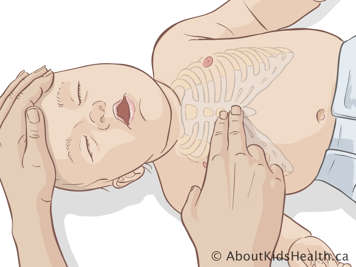What causes choking?
Choking occurs when something is stuck in the throat, blocking the airway to the lungs. This blockage can be partial or complete. The airway is the path air travels down to get to the lungs. Most choking episodes, such as those caused by liquids, clear without a need for assistance. When the airway is blocked, this is called foreign body airway obstruction.
How to tell if your child is choking
A mild choking episode may cause your child to cough, gag or vomit. Your child's face may also turn very red. If your child is having a more severe choking episode, they will not be able to breathe, cry or speak. Their skin, lips, and nails may turn a purplish-blue colour.
The following information does not replace real, hands-on CPR training or training on how to deal with choking. CPR courses are often available through local recreation programs, advanced swim programs, and first aid programs. In Canada, such programs are offered by the Canadian Red Cross, Heart and Stroke Foundation and St. John Ambulance for example. The basic skills are simple and usually only take a few hours to learn.
What to do if your child is choking
Check to see if your child is responsive
Tap your child gently and ask loudly, "Are you OK?" If they do not answer, call 911. If you have someone with you, get them to call 911 and get help.
If your child does answer, encourage them to cough up the object on their own. Do not hit your child on the back to remove the object. Do not give your child anything to drink. This can block air from getting to the lungs.
Check to see if your child is breathing
If your child is not breathing and is unresponsive, call 911 and begin CPR. If you have someone with you, get them to call 911 and get help.
If your child is unresponsive but is breathing, then their airway is not completely blocked. Turn your child onto their side to keep the airway open and reduce the risk of a complete obstruction of the airway, and call 911. Stay with your child until their breathing improves and help arrives.
If your child is responsive and having a more severe choking episode, call 911. If there is someone with you, get them to call for you. You must act right away to relieve the blockage.

Abdominal thrusts
Abdominal thrusts increase the pressure in the chest, which helps to force out the object that is blocking the airway.
If your child is over one year old
- Stand or kneel behind your child. Wrap your arms around your child’s waist tightly, just below their lower ribs.
- Make a fist with one hand.
- Place the thumb side of your fist against the child’s abdomen, slightly above the navel and well below the breastbone.
- Grasp your fist with the other hand and press into the child’s abdomen with quick forceful upward thrusts at a 45-degree angle. This will force out the remaining air in their chest and help bring up the object.
- Repeat thrusts until the object is expelled from the airway or the child becomes unresponsive.

If your child is under one year old
In a seated or kneeling position, place your child face-down on your knees or resting on your forearm. Support the child’s head and jaw with your hand. Using the heel of your hand, give up to five firm back blows between the child’s shoulder blades. Deliver each slap with sufficient force to attempt to dislodge the object.

After giving 5 back blows, if your child is still not breathing, turn them carefully onto their back, continuing to support their neck and head, and place two fingers over the lower breast bone, just below the nipple-line. Using your fingers, perform five quick chest compressions. Alternate between back blows and chest compressions.
If your infant becomes unresponsive, perform CPR, making sure to look into the mouth for the obstruction prior to attempting to provide a breath. If you are alone and 911 has not yet been activated, carry your infant with you to the phone and call 911 as you continue CPR. Continue CPR until help arrives or your child begins to breathe on their own. If your child is breathing but not yet “awake” or responsive, position them on their side and monitor them until help arrives.
How to prevent your child from choking
As children grow, so does their curiosity for the environment around them. Children often make initial contact with an unfamiliar object with their hands, but in a matter of seconds it can end up in their mouth. To prevent this from happening, take the following steps:
- Keep small objects and foods out of your child's reach.
- Eat food only at the table, limit distractions and avoid making your child laugh with food in their mouth.
- Teach your child to chew all foods thoroughly before swallowing and not to drink while still chewing.
- If your child is under four years old, do not give foods such as popcorn, nuts, seeds, hard candies and raw carrots, and avoid sticky foods such as marshmallows, chunks of peanut butter, caramels and chewing gum.
- Cut soft foods such as hotdogs, sausages, cheese and fruit into small pieces. Cut round foods such as grapes, berries and cherry tomatoes in half to make them less likely to block the airway during a choking event.
- Fish bones can get stuck in the back of the throat or embedded in the tonsils.
- Be careful when visiting other homes, and clean up right away after parties.
- Rubber balloon have become the leading cause of choking-related deaths from objects other than food.